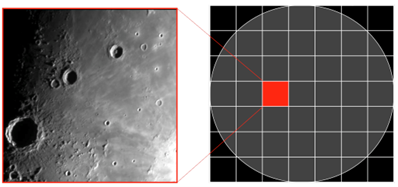You can use the Liverpool Telescope to observe features on the Moon’s surface. This is because the telescope has a field of view that shows small areas of the sky in lots of detail. This means that you would need to combine about 49 images from the LT to cover the entire full Moon.
In this project, you will plan observations of 3 features of the Moon during different lunar phases. You then use Go Observing to request the images of specific areas of the Moon at specific times within the lunar phase cycle. The images you collect will allow you to show and investigate how these features appear to change over time.
By the end of this activity you will:
- Have used your knowledge of the phases of the Moon to plan a series of observations
- Have produced detailed images of features on the Moon using the Liverpool Telescope and image software
- Have demonstrated how the appearance of those features changes with the phases of the Moon
- Have produced a report of your results and analysis
To complete this activity you will need:
- To log into your account
- To watch our guide to making Advanced Observations
IT Equipment
- Access to the internet
- Software for viewing astronomical data files

small areas of the Moon in great detail.
Credit: The Schools' Observatory
Have a go
Investigate: How do your 3 chosen features change as the phase of the Moon changes?
Plan your observations:
Make sure you design your observations carefully. You will need to decide the following:
- the 3 features you will observe and analyse
- the time of the month to begin observations
- the number of observations of each feature
- the time interval between observations
Tips:
- To adequately show how a feature changes as the phase of the Moon changes you need at least 3 images of each feature.
- The features do not all need to be in the same field of view. You can get images from different regions of the Moon.
- Sometimes a feature will not be properly visible in an image. Showing that it is not visible could be part of your plan.
- Mountains are good features to choose because at certain times sunlight only reflects from the mountain tops, with valleys being in shadow.
Submit your observations to the Liverpool Telescope
- Log in to your account
- Go to Go Observing and use the GCSE Options to observe Lunar Features
- Follow your plan and the instructions on the screen to make your observation
- Repeat for your other lunar features
Process your observations
- Download your images.
- Use the image software to open and process your images. This is where you can reveal as much detail as possible from the images.
When you download your observations, the webpage will tell you the details of your observations, including:
- date and time
- telescope and instrument used
- observing site (precise location)
- weather conditions at the observing site
- filter and exposure time
This information is also saved within the file as metadata and can be viewed using the image software (in LTImage, navigate to Image properties via the Astro menu).
You should make a note of this information for your report.
Analyse your results
Compare your images and comment on the similarities and differences. What has changed and why? The more detailed and in-depth your explanation, the better. Try to use numerical data to back up your descriptive comments.
Things to consider:
- the angle of sunlight
- the position of the Earth, Moon, and Sun
- the length of the shadows
You may want to add labels of times, dates, and significant features in your images. Make sure to give explanations for any astronomical vocabulary you use.
Reach a conclusion. How have your 3 features changed with the lunar cycle? What have your learned?
Evaluate your results
How accurate are your images? What were the limits of the project? How could you improve the project if you did it again?
Produce a Report
A scientific report clearly and accurately communicates what you intended to investigate, as well as the results of that investigation.
It should contain:
- your observation plan
- your images
- your analysis
- your evaluation
And make sure you include the following details about your equipment and methods:
- the equipment you used (telescope, instrument, and software)
- date and time of observation
- observing site (precise location)
- weather conditions at the observing site
- filter and exposure time
- rise and set times of the Moon
- phase of the Moon
- why you chose the features
